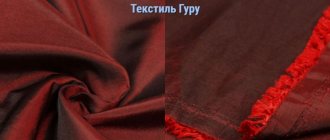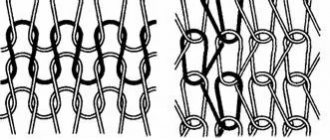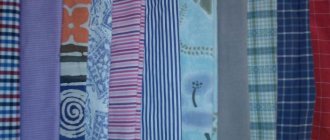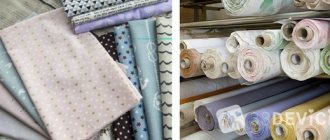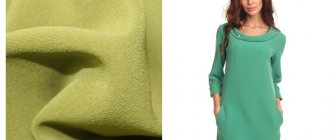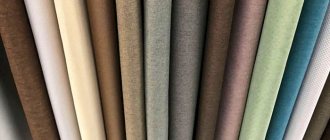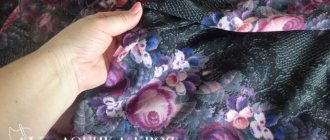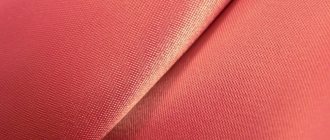Taffeta is a fabric with a glossy sheen., woven in a plain weave from natural, artificial or mixed yarns. You can learn more about curtains consisting of single threads in this article. This fabric was first made in Persia from natural silk. Then the production of this material was organized in Byzantium, and cotton or blended yarn was used for its manufacture.
Modern fabric is usually made from tightly spun synthetic threads, usually consisting of polyester or acetate.
This is a dense fabric that holds its shape well . A type of taffeta material - shanzhan - has an interesting iridescent color.
Advantages and disadvantages of taffeta curtains
This fabric has a very wide range of applications, as it has a chic appearance, good dimensional stability and a dense texture. Draperies made of majestic velvet look no less attractive, about which you can learn more here.
The main advantages of the fabric are as follows:
- has water-repellent properties;
- lends itself well to draping;
- looks solemn, elegant and noble;
- quite strong and durable.
The disadvantages of taffeta include the need for delicate care, since when it is strongly crumpled, folds form, which are very difficult to get rid of.
This fabric shrinks when washed in hot water , so it is washed with gentle detergents at a water temperature of no more than 30 degrees.
When drying, curling should be avoided, and ironing should be done at the minimum temperature setting of the iron from the wrong side and through damp gauze.
Taffeta made from natural fibers, like linen, silk, and cotton, allows air flow well, is environmentally friendly, and has dust-repellent properties; those made from synthetic threads are stiffer, lighter and denser.
What is taffeta?
Taffeta is a variation of a dense glossy fabric with a fine weave. In the manufacture of the material, tightly twisted threads are used, due to which the unique qualities of the material are achieved.
Ancient Persia is considered to be the birthplace of taffeta. Even then, this material was held in high esteem by the rich. This fabric was made by hand from real silk threads, which, in principle, determined its high cost. Over time, the attitude towards her has not changed.
Natural matter is still very expensive to this day. However, today there are good synthetic analogues on the market.
They are more affordable, although they are not inferior in appearance to their counterparts, have a rich palette of colors, are able to create spectacular folds, but at the same time they require more meticulous care and have a shorter service life.
Depending on the raw materials used, taffeta for curtains can be:
- Silk. That is, made from fiber that is extracted from the cocoon of the silkworm. This fabric has an expensive price, which is justified by the best consumer qualities: environmental friendliness, hypoallergenicity, wear resistance, and the ability to absorb moisture from the air.
- Cotton. Made from plant fiber. It has the same qualities as silk taffeta.
- Viscose. Made from artificial material – regenerated cellulose. Its price is strikingly different from the cost of natural matter. However, it is less wear-resistant and inferior to the previous ones in tensile strength, which is very noticeable in a wet state.
- Acetate. Made from synthetic materials. It is cheap, but its weak side is its poor consumer qualities.
Related article: Leveling the floor with a self-leveling mixture: screed and drying time of the self-leveling mixture, preferably gypsum and cement
There are possible options for using mixed fabric - when natural and artificial fibers are combined in different proportions in one fabric.
Depending on the color, taffeta fabric is:
- Plain. When production uses identically dyed warp and weft threads.
- Shanzhan. This material has a generous color palette. When viewed from different lighting angles, the fabric changes color, shimmers and smoothly flows from one tone to another. This effect is achieved through the use of multi-colored fibers for the warp and weft threads.
In addition, taffeta material differs in texture and can be smooth, crinkled or printed.
The head qualities and properties of matter depend on the source material. At the same time, there are a number of properties that are inherent in all types of material.
- water-repellent properties, which are achieved due to the density of the weaving;
- wear resistance - the material has high strength, due to which it does not become thinner and does not wear out over time;
- durability – careful care ensures a long service life;
- aesthetics - the fabric has a glossy shine that ennobles it. Draps well, creating tight creases. Maintains shape.
Like any other fabric, taffeta has its downsides:
- crumbles when cutting;
- shrinks after it is washed;
- wrinkles a lot, it is possible to form folds and creases that are difficult to smooth out, and requires meticulous care.
Types of taffeta curtains
Taffeta is a versatile fabric. It is suitable for sewing curtains of both the first and second plan.
For example, chameleon taffeta wonderfully softens curtains with iridescent shine and lightness. From this material you can choose curtains for the bedroom, the living room, the office, and even select curtain models for the kitchen.
Using this fabric you can create a window interior in any style. For example, fabric in bright and rich colors with a metallic sheen will look good in the kitchen. You can learn more about the rules for selecting curtains by color here.
Textiles in pastel shades will fit perfectly into the classic interior of the living room.
You can sew striped Roman blinds from taffeta.
Modern taffeta can be any shade, plain or embroidered. It can be used in any interior style, from modern and baroque to high-tech or even fusion.
When sewing curtains from such material, you should remember that the fabric slides and bunches strongly under the sewing stitch .
Punctures with a sewing needle remain noticeable, so it is better to entrust sewing taffeta curtains to professionals or buy ready-made curtains.
Wide range of models
Taffeta curtain fabric is a universal material. It is used both for sewing curtains and curtains. Curtain products made from this fabric are used to decorate window openings in the living room, bedroom, nursery, dining room, and kitchen. For example, a chameleon taffeta curtain with eyelets will be an excellent addition to the living room interior design. If the guest room is decorated in a classic style, then the best choice would be a curtain in pastel colors. Thicker curtains made of synthetic taffeta with flock are suitable for a home office. For kitchen decor, we recommend fabric in rich colors with shine.
The modern range of taffeta curtains pictured are available in a variety of shades, printed and plain embroidered. These products are quite suitable for interior design in high-tech, modern, baroque, and fusion styles.
Should I buy ready-made curtains or sew them to order?
Despite the advantages of the material, the fabric slips when cutting and sewing, which creates certain inconveniences for creating the product. Therefore, it is recommended to entrust the sewing of taffeta curtains to professional seamstresses or to purchase ready-made products. Moreover, the range of curtains allows you to choose the most suitable option for any interior. Typically, ready-made curtains are equipped with curtain tape or eyelets, which is very convenient for use.
The assortment of retail outlets widely includes taffeta curtains in a variety of colors, in Roman, classical, and Chinese styles. These products fit perfectly into any interior design style.
Reviews from housewives about taffeta curtains are usually positive. These products transmit light and are perfectly combined with dense fabrics that are used to decorate interior design. For example, when decorating a window opening with curtains made of chameleon fabric in the living room, a sofa and a lampshade on a floor lamp can also be supplemented with decorative elements from the same fabric. The shine of the material will create a solemn, elegant atmosphere in the room. To summarize, I would like to note that taffeta curtains will perfectly decorate the interior of any room. A wide selection of these products, a lot of positive reviews and the luxurious appearance of the material will not allow you to doubt the correct choice for decorating window openings. However, you need to remember that this is a rather delicate material that requires delicate care.
How to choose ready-made taffeta curtains
This fabric is difficult to sew, it is easy to ruin with poor stitching and is not easy to cut. This is why most buyers prefer to buy ready-made curtains.
Purchasing ready-made curtains has the following advantages:
- no need to wait for them to be made or bother with sewing and cutting;
- curtains have rings or loops for easy hanging;
- You can immediately try them on the window and evaluate the harmony with the interior, and also return them if they don’t fit well;
- Usually, ready-made curtains cost an order of magnitude cheaper than custom-made curtains.
Living room draperies made of taffeta
Using this fabric to decorate your living room, you can create a very romantic, noble and festive interior.
It is suitable both for making first-order curtains (drapes) and for sewing curtains.
This fabric is capable of forming luxurious draperies, so it is perfect for sewing curtains.
Taffeta curtains for bedroom
In a luxury bedroom, double curtains look elegant, where taffeta is the first level curtain. Combining fabric with organza trims, you can achieve the effect of lightness, mystery and romanticism.
Such curtains will look very delightful , but purchasing or sewing them will not be cheap. Or, for example, use translucent chameleon taffeta over a simple opaque plain fabric.
This combination looks unusual and modern.
Decorating windows in the kitchen with taffeta curtains
Roman blinds will look natural in the kitchen. For them, it is better to choose a plain and dense fabric. If the kitchen is made in high-tech style, then curtains with eyelets with a metallic sheen will help add coziness.
A classic-style kitchen with a small window will be decorated with curtains with lambrequins made of taffeta and mesh of the Buff model: two curtains and a two-tier lambrequin, made in the form of a double-sided drapery .
Taffeta curtains are so versatile and diverse that they absolutely do not limit the designer’s flight of imagination.
This fabric is ideal for sewing curtains and interior decoration. With its help, you can create both a feeling of lightness and a sense of solemnity; it always looks noble and expensive.
Features of taffeta curtains
Taffeta curtains in the interior shimmer with beautiful shades under the influence of lighting emanating from lamps. The smooth, glossy surface of the material easily folds into soft folds of drapery. If necessary, taffeta for curtains can take any shape, beautifully framing the window opening. Any room decorated with such curtains takes on an elegant, festive appearance.
Designers recommend using taffeta curtains in living rooms, bedrooms, and kitchens. Shiny curtains look especially impressive in the interior of country houses. The lightness of the fabric creates a relaxed atmosphere in the room, conducive to long, friendly conversations.
